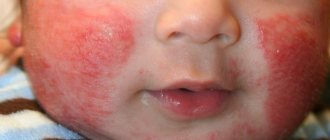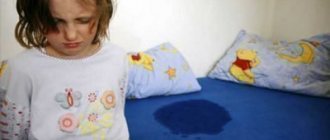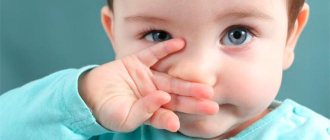Often, fear in a child is confused with the concept of “fear”. Parents need to learn to distinguish between these manifestations, which are different in nature. Fear, according to psychologists, is a short-term emotion, a child’s reaction to a perceived or real danger. It helps develop everyday experience, teaches caution and teaches the instinct of self-preservation. Fear is a reaction of the nervous system (reflex), which, in addition to fear, manifests itself in other forms of emotions.
What is fear in a child, what is its nature and symptoms, what consequences does it have and how to treat it - let’s look at it in more detail.
Risk group
Every child can get scared, but there are also children who are more susceptible to fear - for example, kids whose parents are overprotective and protect them from negative experiences. As a result, the child becomes afraid when faced with shock.
Children whose parents constantly tell them about the danger also suffer. It is believed that every second object poses a danger to humans, but harm is rarely caused. You cannot prohibit your child from enjoying absolutely everything, including communication with pets.
Children with diseases of the central nervous system find it difficult to cope with negative emotions.
Symptoms
Many symptoms occur in every frightened child, but if the condition does not change for a long time and even worsens, then this is a “bell” for parents: something needs to be done to avoid unpleasant consequences.
Attention! Psycho-emotional problems must not be neglected - otherwise the baby will face severe psychological trauma that will leave an imprint for life.
Let's look at the most common signs.
- Restless sleep with or without nightmares. Oddly enough, even a one-year-old child sees nightmares in his sleep - in fact, this is a transformation of negative experiences.
- Constant tears. If an infant is fed and dry, but constantly cries and is nervous, then this is a signal that he needs to be treated.
- Refusal of breastfeeding.
- Fear of the dark.
- Involuntary urination. Enuresis is not diagnosed until age 4, but if urination continues, this indicates problems with the psyche and central nervous system.
- Stuttering. Such symptoms are typical for children over 4 years old, that is, when the child is already speaking. In severe cases, the child may stop speaking altogether.
- Fear of being alone in a room. If the baby does not want to be left alone, even to sleep in a separate room, then this may be due to the fact that he once experienced fear alone.
It is difficult to recognize fear and assess the mental state in infancy, because the child is not yet able to talk about what is bothering him.
How to give first aid
Of course, first aid to a baby in a moment of fright should be provided by an adult nearby. It is very desirable that this person be a mother or someone close and well known. It is quite obvious that the onset or non-occurrence of the negative consequences of fear on the health and psyche of the baby largely depends on how the adult behaves. It is very important with all your appearance to make the child understand two things: firstly, that he is loved and will not be offended; secondly, that nothing worthy of serious panic had happened. Important! The reaction of adults should be aimed at making the baby calm down and feel protected. Parents' panic, loud screams, noisy expressions of sympathy and other fuss concentrate the child's attention on the incident and assure him of the idea that something terrible has happened.
Proper help for a child when he is scared should include two main components:
- Affection, love and tenderness.
- A gentle shift of attention to something positive.
If we are talking about a very small child, take him in your arms, gently caress him and calm him down with even and quiet words. The baby will not understand their meaning, but will perfectly feel the general mood. You need to talk more substantively with an older child. Try, without losing your composure, to explain to the child what caused his fear (you may even need to confirm that there were reasons for the fear), but be sure to tell him under what conditions there is no need to be afraid of danger. Familiarize yourself with the causes of colic in newborns. For example, a thunderstorm It’s not scary if you’re in the house, but once you’re outside, you shouldn’t try to hide from it under a tree; it’s better to find dense, low-growing thickets. The child must clearly understand: there is salvation from any danger, this will develop a positive attitude in him, will not allow him to concentrate on fear, and at the same time will form knowledge that may someday save his life.
What can scare a child and what parents should do
Any baby requires special attention; even natural phenomena can frighten him - for example, thunder and thunderstorms, especially if the newborn has not yet encountered them. Loud, extraneous, unfamiliar sounds are also dangerous. You should not yell at your child or be too strict with your child. It is recommended to accustom children to kindergarten gradually.
If it is already clear that the baby has certain fears, you need to identify the reasons for their appearance. You can't leave your baby alone. It is recommended to bathe him in soothing baths - for example, with pine needles.
It is better for the baby to get used to the presence of strangers. Guests should appear occasionally and gradually. Parents should communicate with strangers at ease, thereby showing the baby that they do not pose any danger. It is possible for guests to bring gifts and treats to the child.
Get your baby used to pets as well. You can start your acquaintance with pictures and videos, telling them that animals are friendly, so there is no need to be afraid of them. Don't worry if your baby gets burned on a hot cup - it's actually an experience for him. The same applies to household items and appliances - it is necessary to explain to the child how to use them correctly.
In search of the root cause
Traditionally, before fixing the problem, we find out the cause. Babies up to about three years of age are not able to control psychological reactions, so they can be frightened by something that does not evoke absolutely any emotions in an adult.
- Animals: Most often these are large dogs that try to sniff the baby. They can suddenly approach the baby’s face or jump with their front paws onto the stroller, and this, frankly, will make an adult’s heart skip a beat.
- Loud or sharp sounds: parental quarrel, the sound of a car exhaust, the roar of a motorcycle, lightning, etc.
- The inadequacy of parents who, for example, try to put a newborn to sleep with a loud cry.
- A sharp change in the situation. For example, while bathing, a baby may slip from your arms and go under water.
Fright Therapy
Any fear is a psychological problem. Therefore, treatment must be done very carefully, so never neglect children's fears or treat them with cruelty.
The first step is to determine what caused the fear. As a last resort, you can contact a psychologist so that the consequences of ordinary fear do not develop into a phobia.
If you cannot cope with your child’s fears and prevent their symptoms, you will have to seek professional help. As a rule, it all starts with a trip to the pediatrician, who will recommend seeing a psychotherapist and neurologist.
Hypnosis
It is quite difficult to treat a child's fragile body. Hypnosis is usually used when bedwetting is present. This approach gives an excellent effect and cure in almost 100% of cases.
Homeopathy
This technique implies an exclusively individual approach. Knowing the symptoms, the doctor selects medications.
Fairy tale therapy
With the help of fairy tales, parents and doctors try to change the child’s attitude towards the world around him and rebuild his psyche in a positive way. It’s good when group therapy is carried out - in this case, the kids communicate, retelling and discussing the plot of the fairy tale, then make sketches.
Discussing the behavior of the main character allows the child to understand what is bad and what is good, as well as what to do to overcome their fears and experiences.
Play therapy
In this case, kids participate in staging all kinds of skits. The game allows you to build relationships with partners in the skit, making the child more open and allowing him to adequately relate to his own fears.
Traditional methods
Along with traditional methods of dealing with fears, there are also folk methods. However, some believe that it is not possible to cure fear using folk remedies. So, it is recommended to give the baby warm sweet water immediately after he has experienced fear. Some people advise reading prayers and special spells, rolling out fears with an egg or pouring them on wax.
At the same time, you need to understand that many methods are questionable, so at the same time you should seek professional help.
Consequences
If infantile fear is not recognized in a timely manner, its consequences can be dire. Sometimes children themselves outgrow fear that appeared in infancy. At the age of one, he may be very afraid of dogs, and by the age of 9 he will want to have one for himself. But as medical practice shows, the consequences of fear in adulthood can develop into serious problems. Such a person may experience panic attacks and hysterical attacks. As a result, the following problems develop:
- nervous tics and stuttering;
- the child practically stops talking, which entails mental retardation;
- endless nightmares lead to the development of severe aggression;
- on the basis of this, a number of phobias develop in relation to people, animals, certain objects and situations;
- the child begins to speak often at night.
Such consequences entail serious disturbances in the psyche and the functioning of internal systems, especially the cardiac, vascular and genitourinary.
Fear can result in regular nightmares
Traditional therapy
Today there are many methods, both traditional and non-traditional, that help cure severe fear in children at any age. Let's look at each method in detail.
Treatment of fear in children involves a number of activities aimed at strengthening and healing the body:
- sports, hardening, dousing, dancing;
- balanced diet, use of sedatives that have a beneficial effect on the psyche;
- maintaining a sleep schedule;
- taking a warm bath or shower in the morning and evening.
These very simple measures will help your baby get rid of fear in a fairly short period of time.
ethnoscience
Wrapping a baby in a damp sheet or diaper helps very well when a baby is frightened. To do this, you need to undress the baby and wrap it in a damp cloth for half an hour.
Drug treatment of fear in children is prescribed by specialists - neurologists or psychotherapists. Before starting such treatment, the doctor must check whether the child really has a fear.
But, as practice shows, taking medications to treat such a reaction in children is rarely practiced.
Traditional medicine will help. It uses several effective ways to treat this disease.
- To relieve a child’s state of shock, he needs to be given a warm drink - tea, a glass of water (necessarily with sugar). Infusions of medicinal herbs have proven themselves very well.
- Traditional healers use prayers and spells in the treatment of childhood fear.
- Egg rolling is one of the most ancient and reliable ways to get rid of this problem in childhood.
- Healing with holy water.
Herbal infusions
Properly prepared herbal decoctions and herbal baths have a calming effect on the nervous system and the entire body as a whole.
To treat children's fear from dogs, thunder, loud and scary sounds, you can use the following herbs:
- chamomile;
- hop and angelica root;
- St. John's wort inflorescences;
- stinging nettle leaves;
- heather;
- Melissa
You need to take a pinch of each herb and brew it with a glass of boiling water. Infuse the decoction for two hours, take 50 g 2 times a day. The result of treatment will appear within a month after completing a course of traditional therapy.
There is another option on how to cure childhood fear between the ages of 2 and 11 years. To prepare the decoction you will need several herbs:
- valerian;
- heather;
- motherwort;
- cottonweed.
Mix 2 parts of each component and add two liters of boiling water. Leave covered for two hours. Take 4 times a day throughout the day. The course of treatment is 9 days.
Heather will help calm fears
Prayers
The causes of fear in infants and children of any age can be eliminated with the help of effective prayers. The evil eye can also be cured in this way.
This rite is only suitable for baptized children. The child is seated or placed in a crib in the middle of the room. The person reading the prayer should stand behind him. A church candle is lit, then prayer words are read:
“Fear leave the heart, head, bones and blood of the servant of God (name). Almighty, free the patient’s thoughts from all negativity, cleanse his soul and body from fear and fear. Amen".
This prayer is read for older children.
For infants and children under 3 years of age, a different prayer is read. It helps cure fear of the dark, various phobias and fear.
You need to read strong prayer words three times a day - before breakfast, lunch and dinner:
“Leave Satan the body and head of God’s servant (name). I drive out infantile fear from bones, blood, muscles and all human flesh. It’s not me who drives me out, but the Lord God who frees me and heals me. Amen".
Conspiracy from fear
Water spell
Sometimes, when a child is very frightened, who constantly talks in his sleep, pees, cries and is hysterical, prayers are powerless. Then a strong conspiracy, which is read on the water, can help. It helps to cure a child at an early age, when the problem has not yet started.
To carry out such a ritual, one of the parents needs to go to church, purchase fresh holy water and thirteen candles. After the waning moon phase begins, you need to light all the candles, place a container of holy water next to them and, looking at them, say the following spell:
“I look at the holy water and ask God for healing for my child. Our Lord Almighty, drive away all fears, frights and all evil spirits from my child. May my child be healed with holy water, may his thoughts become bright and pure. Amen".
After reading the plot three times, wait until the candles burn out. Wrap them in paper or scrap cloth and throw them away at an intersection. Wash the child three times with holy charmed water. The procedure must be carried out three days in a row, in the morning, at lunch and in the evening.
Conspiracy text
Wax casting
There is another option to cure fear in a child - wax casting. To perform this ritual, you will need wax - 150 g (you can use wax candles without a wick), as well as water - 2-3 liters.
The frightened baby is seated in a chair. Over a lit burner, melt the wax in a ladle or metal mug, and, holding it over the baby’s head, pour it into a container of water. During the pouring process, you need to read the spell words:
“The Holy Mother of God, the angels, archangels and all the apostles stood on Pine Mountain, driving out fear and fear from my child. They healed the soul, body, blood, head and bones of the servant of God from all evil spirits and dark thoughts. I pray to You, Most Holy Theotokos, that my child will become healthy and that his fear will leave him forever. Amen".
After reading the plot, the poured wax must be taken to a vacant lot far from the house and buried in a deserted place. Water is poured onto the street or into the toilet.
Egg rolling
This is another very powerful ritual, after which the baby’s fears and fears disappear. To perform this you will need a homemade chicken egg, 3 candles and church water.
The patient is seated in a chair. A container of holy water is placed at the head of the bed, and candles are lit nearby. An egg is taken and rolled over the entire body, starting from the head to the very feet. While rolling out, the “Our Father” prayer is read three times. After rolling out, the egg is driven into a bowl of water. The contents of the jar should be poured onto the street or into the toilet. After this you need to cross yourself three times.
The egg rolling procedure is carried out for three days in a row. After this, you will notice how your baby has become calmer and stopped being afraid.
Preventive actions
It is better to prevent any disease than to treat it. If you see that your baby is often scared and capricious, add chamomile or valerian tincture to the bathing water. You can make small bags of dry medicinal herbs (for example, motherwort or lavender) and put them in your baby's bed.
Never instill false fears. For example, a child should not be afraid of street animals. It is necessary to explain to him that if you do not offend them, then they will not attack, that is, kindness begets kindness.
If you know that a lot of stress awaits your child, be sure to take his favorite toy. By cuddling a bear or doll, the baby tries to cope with stress on his own and feels safe.
At home, the child should be surrounded with warmth and the most favorable atmosphere should be created. Also try not to swear in front of children.










